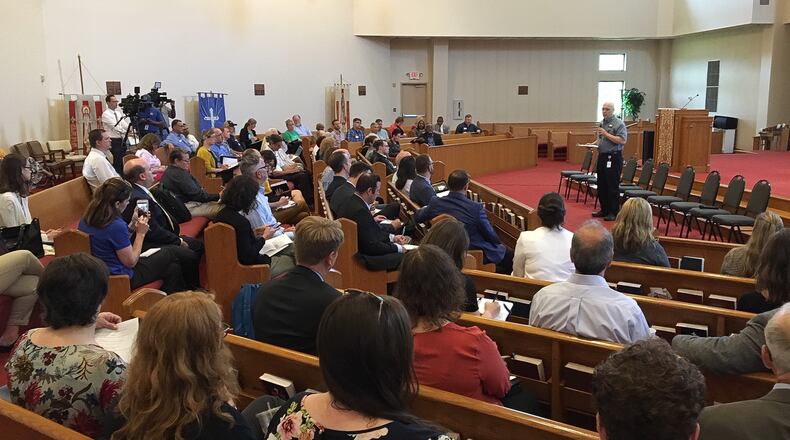MORE: FEMA help available for tornado victims; President Trump declares disaster area
Jordan told about 80 people from county government and a dozen non-profit groups coordinating recovery efforts from the destructive Memorial Day to prepare for a long haul.
“Long-term recovery, we are looking at a rule of thumb, two years,” he said of the EF4 tornado that he called particularly harsh.
“It almost seemed to target those areas with the lowest rates of insurance. Certainly. some of the other areas were hit. I saw really nice brick homes completely obliterated,” Jordan said. “But disproportionately, the survivors of these tornadoes were uninsured, and certainly under-insured.”
As many as 2,000 people in Montgomery County may require help, said Michael Vanderburgh, the executive director of the St. Vincent DePaul Society, who is heading the county’s long-term recovery operations group.
Vanderburgh said the group has looked toward rebuilt communities in Oklahoma and Texas to mold a response to the disaster.
“It’s still too early for us to know the full extent of what we’re dealing with. But based on models from similar incidents around the country, we’re looking at an average of two-year active recovery,” Vanderburgh said.
MORE: Community-by-community survey of tornado damage, cleanup efforts
Case managers a key
The people who met Wednesday at St. Margaret’s Episcopal Church in Trotwood split into five working groups arranged to address housing, employment issues, volunteer coordination, business recovery and disaster case management.
The goal of the effort is to provide tornado survivors a central point — a case manager or recovery navigator — to help access needed resources, said John Pyron, director of disaster response for Lutheran Social Services.
“As we move into the long-term recovery phase, we’ll begin to see unmet needs — under-resourced and unmet needs. Insurance settlements won’t be enough to meet the need,” Pyron said. “So what we want to do in the long-term recovery process is ensure that a disaster survivor and a family has one point for disaster assistance through the long-term recovery process, and that would be a disaster case manager.”
PHOTOS: Tornado outbreak in Miami Valley
The group working on case management will meet today in order to figure out a data management system to share tornado survivors’ specific needs across the organizations so one problem doesn’t cascade into another and another, Pyron said.
“They lost a car but they need the car to get to work. If they don’t get a car, they could potentially lose their job, which then if they lose their job, they lose their source of income that can then lead to losing housing,” he said. “So, the idea is to really get to those needs as quickly as possible.”
Hundreds of housing units uninhabitable
A big challenge moving forward will be getting the centralized process running smoothly – as well as provide a mechanism for people who need help with housing, said Amy Radachi, president and CEO of Rebuilding Together Dayton.
“There’s the housing piece, there’s the employment piece, there are so many pieces to this puzzle that we are still figuring out how to start,” she said.
A preliminary damage assessment by the government showed tornadoes rendered about 630 residential structures in the county uninhabitable. But the precise number and their locations remain unclear, and the data may be hard to gather without another count by a group such as the National Voluntary Organizations Active in Disaster, Radachi said.
MORE: Dayton tornado victims wish they had more time to move
One hitch identified Wednesday with a centralized system is that personal information given to one organization by survivors can’t be shared with others, she said.
Said Radachi: “The Red Cross has done an amazing job of canvassing, but … how do we obtain that information without the violation of anybody’s privacy?”
The data management system will evolve, but in the meantime storm victims should get into the Red Cross system if they haven’t already and register with FEMA, which can be done online or over the phone, organizers said.
FEMA team arrives
A FEMA team will arrive in Montgomery County today to identify disaster recovery center sites where people will also be able to register once those are operational, according to Jordan.
Once registered, FEMA inspectors review damage and talk to the claimants. A person could be provided funds in as few as three to five days after an inspection, according to FEMA.
More than $1 million in private money has already gone into recovery efforts, Vanderburgh said.
The Small Business Administration announced Wednesday it will open business recovery centers today in Beavercreek and Harrison Twp. SBA representatives at will provide information about disaster loans, answer questions and assist businesses in completing the SBA application.
Montgomery County Commission President Debbie Lieberman, who will chair the steering committee, said clean-up and short-term recovery brought out the best in the community, but “we’re not done yet.”
“This next phase — this is going to be the longest … But when we are back, we want to be even better,” she said. “Day-by-day we will get there.”
Groups involved in Montgomery County long-term tornado recovery
The Dayton Foundation
Lutheran Social Services Disaster Response
American Red Cross
St. Vincent de Paul
Sinclair Community College
Miami Valley Community Action Partnership
Catholic Social Services
The Salvation Army
St. Mary’s Development Corporation
Rebuilding Together Dayton
Goodwill/Easter Seals Miami Valley
United Way of Greater Dayton
About the Author

